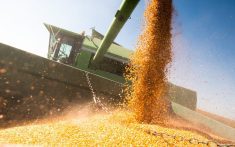Glacier FarmMedia—A grain rally at the Chicago Board of Trade (CBOT) during the week ended May 8 has seemed to run out of steam.
Heavy rains across much of the United States caused delayed plantings for many staple crops. As a result, July corn, soybean and Minneapolis spring wheat contracts all rose to prices unseen since January, while Chicago soft and Kansas City hard red wheat contracts hit their highest prices since December. However, all those contracts underwent negative corrections on May 7 and 8.
Scott Capinegro, a Barrington, Ill.-based strategist for AgMarket.net, said that farmers were “a lot happier than they were five weeks ago” due to the rally. However, profit-taking and dry weather in the forecast saw prices come down a bit.
Read Also

U.S. grains: Chicago grains firm as traders gauge China purchases
Chicago | Reuters – Chicago soybean futures ticked up on Wednesday as traders eyed Chinese purchases of U.S. beans under…
“If the window is opening to plant, it will have problems trying to rally again,” he said. “If you take the whole range of (nearby Chicago wheat contract prices) last year, US$6.5250 (per bushel) was the halfway point of that range. July wheat went to US$6.5375/bu. (on May 7). This is not new longs pushing (prices) up, this is short-covering.”
Citing past experience, Capinegro added that while planting delays will produce rallies, they usually only last for about a week.
“They only average about seven to eight days and we’re getting into that timeframe,” he said. “I think (a farmer’s) making a big mistake in this rally if he doesn’t move some of old crop corn and even price a little bit of new crop.”
The U.S. Department of Agriculture (USDA) will release its monthly World Agricultural Supply/Demand Estimates (WASDE) on May 10 with the trade not expecting any major changes in production and carryout compared to April’s estimates.
Capinegro said he expects the USDA to stay with its trendline yields with bearish figures for corn and soybeans. He estimated new crop soybean carryout to exceed 400 million bushels, while expecting new crop corn to total at least 2.1 billion bushels in ending stocks.
“I still think that we were shortchanged in the March planting intentions (for corn) at 90 million acres. When that survey was being taken, we were at contract lows. You’re asking a farmer what he’s going to plant, he’s going to low-ball it,” Capinegro added. “It’s a big possibility we may, by the fall, see under-US$4 corn.”
After the WASDE report is released, Capinegro added that the trade’s focus will return to weather forecasts.
“You’ll see movement, but then the focus will be what the six-to-10 day forecast looks like. We can plant in three to five days with the equipment we have nowadays,” he said. “If weather seems to straighten out, you’re going to look at the balance of May sideways to down. Over the past couple of years at the start of June, we’ve seen prices start to rally again.”
—Adam Peleshaty reports for MarketsFarm from Stonewall, Man.















